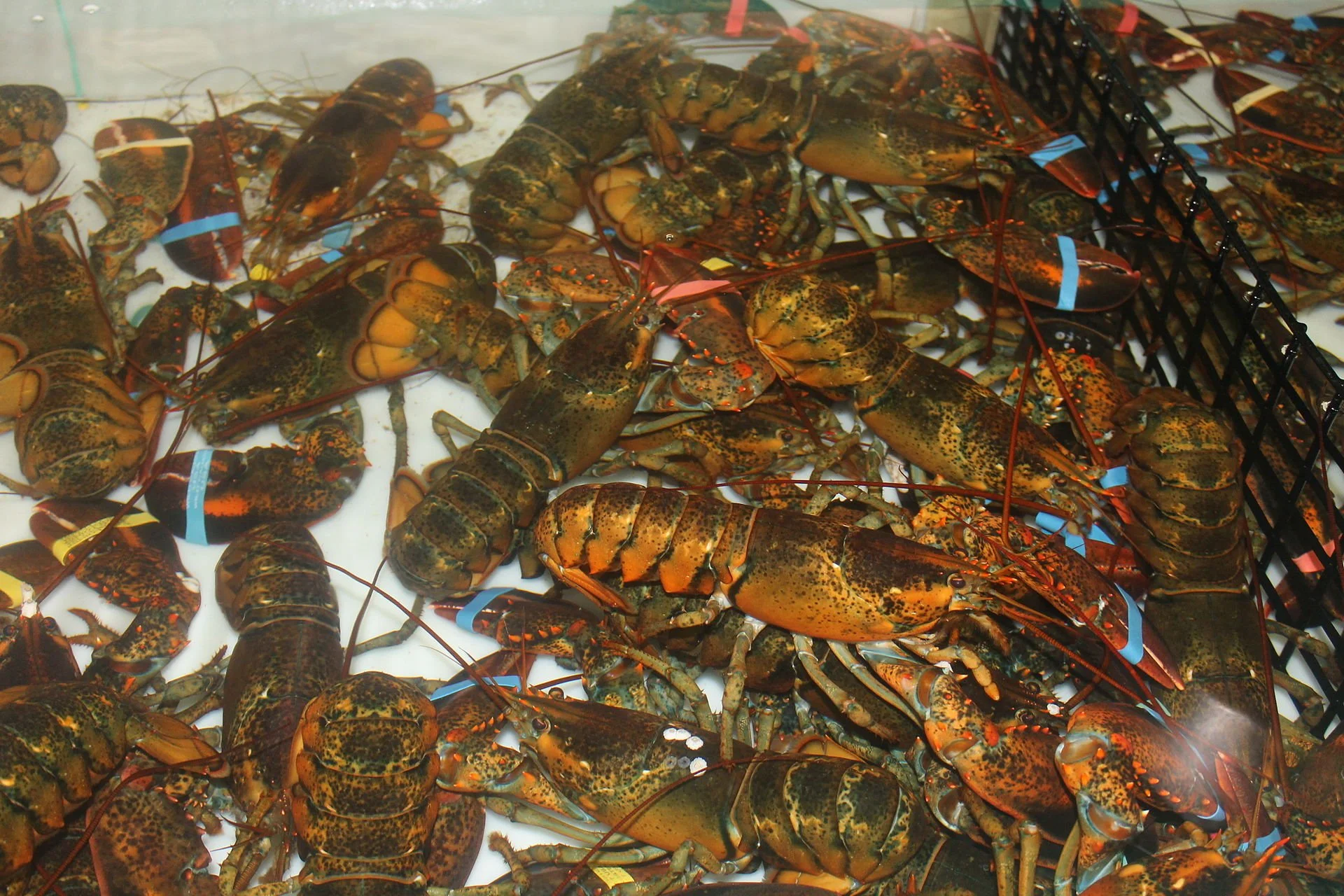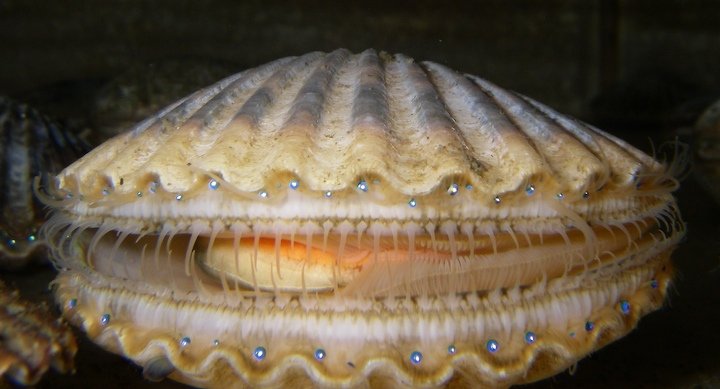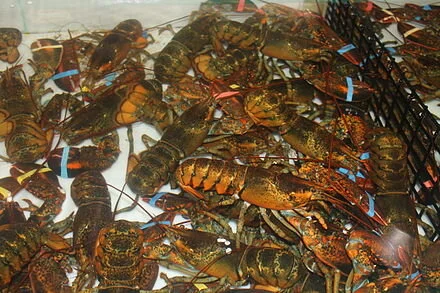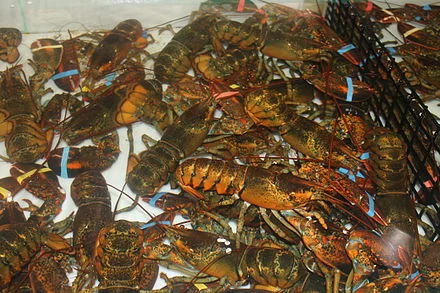
Ocean warming to continue to move lobster, scallop habitats
Lobsters awaiting purchase in Trenton, Maine.
— Photo by Billy Hathorn
An Atlantic Bay Scallop.
From ecoRI News (ecori.org)
Researchers have projected significant changes in the habitat of commercially important American lobster and sea scallops along the Northeast continental shelf. They used a suite of models to estimate how species will react as waters warm. The researchers suggest that American lobster will move further offshore and sea scallops will shift to the north in the coming decades. {Editor’s note: New Bedford is by far the largest port for the sea-scallop fishery.}
The study’s findings were published recently in Diversity and Distributions. They pose fishery-management challenges as the changes can move stocks into and out of fixed management areas. Habitats within current management areas will also experience changes — some will show species increases, others decreases and others will experience no change.
“Changes in stock distribution affect where fish and shellfish can be caught and who has access to them over time,” said Vincent Saba, a fishery biologist in the Ecosystems Dynamics and Assessment Branch at the Northeast Fisheries Science Center and a co-author of the study. “American lobster and sea scallops are two of the most economically valuable single-species fisheries in the entire United States. They are also important to the economic and cultural well-being of coastal communities in the Northeast. Any changes to their distribution and abundance will have major impacts.”
Saba and colleagues used a group of species distribution models and a high-resolution global climate model. They projected the possible impact of climate change on suitable habitat for the two species in the large Northeast continental shelf marine ecosystem. This ecosystem includes waters of the Gulf of Maine, Georges Bank, the Mid-Atlantic Bight and off southern New England.
The high-resolution global-climate model generated projections of future ocean-bottom temperatures and salinity conditions across the ecosystem, and identified where suitable habitat would occur for the two species.
To reduce bias and uncertainty in the model projections, the team used nearshore and offshore fisheries independent trawl survey data to train the habitat models. Those data were collected on multiple surveys over a wide geographic area from 1984 to 2016. The model combined this information with historical temperature and salinity data. It also incorporated 80 years of projected bottom temperature and salinity changes in response to a high greenhouse-gas emissions scenario. That scenario has an annual 1 percent increase in atmospheric carbon dioxide.
American lobsters are large, mobile animals that migrate to find optimal biological and physical conditions. Sea scallops are bivalve mollusks that are largely sedentary, especially during their adult phase. Both species are affected by changes in water temperature, salinity, ocean currents and other oceanographic conditions.
Projected warming for the next 80 years showed deep areas in the Gulf of Maine becoming increasingly suitable lobster habitat. During the spring, western Long Island Sound and the area south of Rhode Island in the southern New England region showed habitat suitability. That suitability decreased in the fall. Warmer water in these southern areas has led to a significant decline in the lobster fishery in recent decades, according to NOAA Fisheries.
Sea-scallop distribution showed a clear northerly trend, with declining habitat suitability in the Mid-Atlantic Bight, southern New England and Georges Bank areas.
“This study suggests that ocean warming due to climate change will act as a likely stressor to the ecosystem’s southern lobster and sea-scallop fisheries and continues to drive further contraction of sea scallop and lobster habitats into the northern areas,” Saba said. “Our study only looked at ocean temperature and salinity, but other factors such as ocean acidification and changes in predation can also impact these species.”
Ah, that skin-soothing lobster ‘blood’
From The New England Council (newenglandcouncil.com)
“Two graduates of the University of Maine (UMaine) have developed a skin cream derived from lobster hemolymph, which functions within the lobster similarly to blood. The product can sooth such ailments as psoriasis and eczema.
“The product is the latest addition to items that can be traced back to efforts by the University of Maine (UMaine) to find commercial applications for byproducts of the commercial lobster industry. UMaine has worked for years to find additional uses for shells and other byproducts. Marin Skincare was founded by CEO Patrick Breeding and co-founder Amber Boutiette, who learned about the potential for lobster by-products while earning their master’s degrees at UMaine.
“Breeding and Boutiette are currently working with Luke’s Lobster in Saco, Maine, to collect hemolymph. The product has been available to consumers for over a month.
“The New England Council applauds UMaine for providing an innovative course of study encourage such scientific discoveries. Read more from the Bangor Daily News.’’
Diversified fishing; Shifting away from the Sunbelt
Cultured sea scallop.
From Robert Whitcomb’s “Digital Diary,’’ in GoLocal24.com
A wonderful story and video by Maine Public Radio’s Fred Bever describes how Maine fishermen are diversifying to address the challenges posed by overfishing and global warming.
Mr. Bever writes:
“These days it’s mostly lobster, but he {fisherman Marsden Brewer} has fished cod and shrimp, and carted urchin to market. They were all once-vibrant species, but now they’re mostly off-limits after being overfished and weakened by climate change.’’ And Mr. Brewer has moved in a big way into scallop aquaculture.
Jon Gorman, who works at Bangs Islands Mussels, told Mr. Bever:
“I see a lot of growth and you never know. We’re going to be doing scallops, then we’ll be back to mussels, and then the springtime and fall we’re into kelp. It’s fun.”
There are some good ideas in the story for southern New England fishermen.
To see and hear Mr. Bever’s report, please hit this link.
As global warming intensifies, and extreme storms, drought and floods ravage some areas, some predict a reverse migration of people from the southern and western U.S. to such places as the Upper Midwest and inland (!) New England, whose climates are expected to remain relatively moderate and that will continue to have lots of fresh water, which is actually better to have than oil, coal and natural gas!
The big population move to the Sunbelt, with all its socio-economic and political effects, may reverse in the next couple of decades – or before.
By the way, water temperatures in the Gulf of Mexico are four degrees warmer than “normal’’. They’ve often been warmer than “normal’’ for some years now, and at the moment are about 85 degrees. This means more fuel for hurricanes – e.g., Hurricane Michael. Keep burning those fossil fuels and maybe we can get the Gulf up to 95 degrees in the summer in a couple of decades. There won’t be much sea life left, but it will be perfect for a soothing swim. To read more, please hit this link.
Todd McLeish: Warming water may be factor in lobster shell disease in southern New England
Despite more than 20 years of declining lobster populations in southern New England and extensive studies of the shell disease that is a major factor in their decline, scientists are still struggling to provide definitive answers to help restore hope to those working in the local lobster fishery.
A new study of lobsters along the eastern Connecticut coast has found that the disease is linked to warming water temperatures, while progress is slow in efforts to identify probiotics to counteract the disease and to better understand why so many lobsters are blind.
“Epizootic shell disease first appeared around 1996 and became quite prevalent around 1999, and it continues to be prevalent,” said Maya Groner, who conducted the Connecticut study as a post-doctoral researcher at the Virginia Institute of Marine Science. “It’s been a challenge to figure out what the pathogen associated with the disease is. The best evidence suggests it may be a suite of bacteria that chews away at the carapace, but that suite of bacteria changes over the course of the disease.”
Her study found that the increased prevalence of the disease stems from warmer water temperatures that induce the lobsters to molt their shells earlier than usual.
Using data on 200,000 lobsters collected over 37 years in Waterford, Conn., as part of biological monitoring near the Millstone Nuclear Power Station, Groner found that about 80 percent of male lobsters have the disease during warm years, with females contracting the disease at a slightly lower rate.
“Molting their shell resets their health,” she said. “If they don’t molt, there’s no way they can recover. But now that they’re molting earlier in the spring, the molt happens before they’re even challenged with the disease.”
From ecoRI News (ecori.org)
The earlier molt allows the disease to progress longer than if the lobsters molted in summer, as they typically do.
Groner found that for every 1.8-degree increase in the average temperature of the bottom water in May, lobsters molted about six days earlier. In early-molting years, disease prevalence doubled by September.
“It’s very consistent with trends we’ve seen with other marine diseases,” Groner said. “Organisms at the southern part of their range — like lobsters in Long Island Sound — are limited by temperature. They’re at their thermal tolerance limit. So as temperatures increase, they’re becoming stressed and less able to cope with diseases.”
University of Rhode Island fisheries researcher Kathy Castro has been studying lobsters for more than two decades, and she decided to look for a solution to help lobsters recover from the disease even though the precise cause of the disease is still uncertain. She is collaborating with URI colleagues who are studying probiotics on oysters.
“Why can’t we identify good bacteria that normally occur on lobsters, take the bad bacteria off, and repopulate their shells with good bacteria?” she wondered. “In essence, the idea works, but we don’t know what’s the right bacteria, how do we treat the lobsters, how often, and how to do it in a reasonable time frame.”
In a laboratory setting, Castro’s URI colleagues David Nelson and David Rowley isolated probiotics from healthy lobsters and tested them against what they believe may be the “bad bacteria.” The strategy looked promising. Initial trials on adult lobsters were positive as well. But it may not be practical.
“Our initial idea was that lobstermen could treat the lobsters on their boat,” Castro said. “But it’s hard to do; you have to do it in a lab. Maybe we still haven’t identified the right probiotic. And are we even working with the right pathogens?”
While that work is continuing, Castro is investigating why about half of the lobsters she has tested are functionally blind.
“That’s a more concerning issue to me than shell disease,” she said. “My question is, is it related to shell disease. The lobster’s endocrine control system is located in their eye stalk, so if a lobster is blind, is it molting incorrectly, and is that contributing to the disease.”
Castro said a colleague in Virginia thinks the cause of the blindness may be manganese, a neurotoxin that harms optic nerves and is released from sediments under low-oxygen conditions. But studies are just now under way.
“In my mind, it has to be related to shell disease. That’s my gut feeling,” Castro said.
One of the challenges to finding the answers has been inadequate research funding, Castro said, so much of the research is being done piecemeal.
“I really wish there was something fundamentally easy that we could do to solve all these problems,” she said. “That would be my greatest dream. But I know it takes time. And as much as we know about lobsters, there’s a lot more we don’t know.”
Rhode Island resident and author Todd McLeish runs a wildlife blog.
The Maine way to boost lobster stocks
From Robert Whitcomb's "Digital Diary,'' in GoLocal24.com:
Southern New England lobstermen (or should I say lobsterpersons?) may have hurt themselves by taking as many lobsters as they can, without looking at the species’ ability to reproduce. It may be a case of “the tragedy of the commons’’ -- wherein individual users in a shared-resource system acting independently in what they see as their own self-interest undermine the common good by depleting that resource through their collective action.
Has that attitude had as much impact on the plunging lobster stocks along the Massachusetts, Rhode Island and Connecticut coasts as environmental changes, especially warming seas? Hard to tell. Commercial fishermen are notoriously independent and secretive about their catches.
You can’t but think of that when you learn that many Maine lobsterman have long used what seems to be a very effective conservation method. As reported by Fred Bever for Maine Public Radio:
For years, Maine lobstermen have used "’V-notching’: when they found an egg-bearing female in their traps, they would clip a ‘V’ into the end of its tail, and throw it back. The next time it turns up in someone's trap, even if it's not showing eggs, the harvester knows it's a fertile female, and throws it back. Later, the lobstermen also pushed the Legislature to impose limits on the size of the lobster they can keep — because the biggest ones produce the most eggs.’’
“And those fertile females have been doing that job very well in Maine. Since the 1980s, lobster abundance here has grown by more than 500 percent, with landings shooting up from fewer than 20 million pounds in 1985, to more than 120 million pounds in 2015 with a value of more than a half billion dollars.’’
To read more, please hit this link.
https://nenc.news/research-concludes-maine-conservation-technique-helped-drive-lobster-population-boom/
Killing mosquitoes -- and lobsters
http://www.ecori.org/connecticut-news/2014/7/29/spraying-for-mosquitoes-a-risky-proposition.html No surprise here: Spraying to kill mosquitoes is bad for other life -- in this case lobsters.







